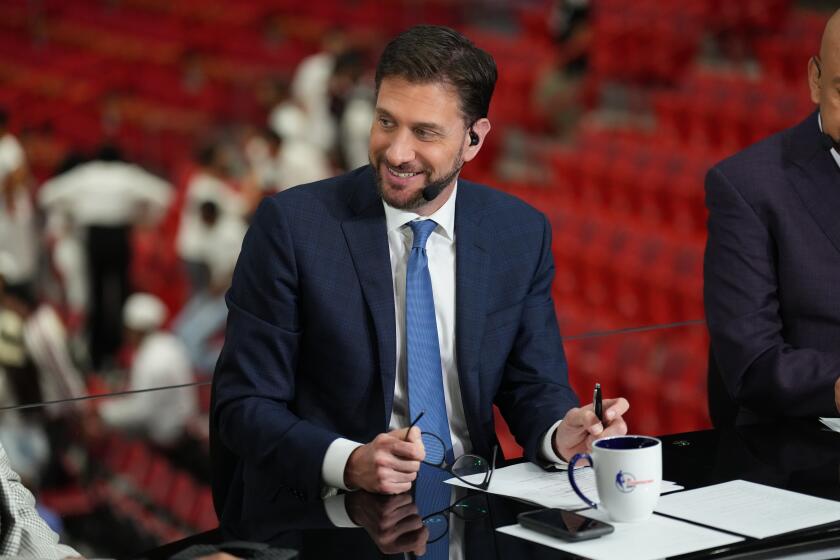Athletes’ cellphone self-portraits an unevolved idea that might have changed Mickey Mantle’s life
In America’s locker rooms, genitalia has become a form of bling. The latest clubhouse trend — athletes who expose themselves in cellphone self-portraits — is the sort of behavior that gets guys arrested in subway stations every day.
Deadspin.com, the in-your-face sports website, revealed last month that Brett Favre sent full frontal self-portraits to a female employee of his former employer, the New York Jets. Deadspin sleuths, who have been tracking this locker room “phenomenon” since January, thoughtfully provided a link to a portfolio of similar pictures. My advice: Don’t go there.
The sexting 41-year-old diva grandpa QB, now playing barely and badly for the Minnesota Vikings, has confirmed leaving voice messages for Jenn Sterger, but disavowed the photographs. The NFL is investigating.
Live by the cellphone, die by the cellphone.
The dexterity and ingenuity of America’s heroes is exceeded only by their ability to stretch the boundaries of taste and decorum and our willingness to indulge it. To wit: the cyber brushfire that erupted recently when a purported nude photograph of Mickey Mantle was posted on HotPrisonPals.com. This studly digital Mick has a chiseled torso worthy of Michelangelo’s “David” — and a better package. “Mickey was such a big slugger,” the New York Post declared in breaking the story. “Damn.”
My iPhone lit up like parched California chaparral. Was this the photograph cited in my new biography “The Last Boy, Mickey Mantle and the End of America’s Childhood”? The one advertised on EBay as “the only known nude photograph of The Mick — ‘Yes, you read correctly, a NUDE photo of Mickey Mantle!’” that was sold to a private collector in 2005 for $25,000?
I called John Rogers, the dealer who made the sale. Rogers assured me that this was not his photograph — one of 33 million images in the John Rogers Photo Archive. To him, it did not appear legit. His naked Mantle was sitting at his locker in an undershirt eating an apple. The picture, taken by the famed Life magazine photographer Arthur Rickerby, had been a mistake, the result of a shutter clicking at an inopportune moment. But, Rogers assured me, “I do have a full-frontal of Yogi Berra and Willie Mays.”
I suppose I shouldn’t have been surprised when two shock jocks out of Detroit refused to believe I had no interest in seeing the Rickerby photo. Any woman who has ever made her living reporting from locker rooms can tell you that the last thing you want to see on deadline is anybody’s equipment, athletic or otherwise. The point was not Mantle’s grandiosity or lack thereof, but the insane and insatiable appetite for getting up close and personal with that which should remain as private and as far away as possible.
But the shock jocks got me thinking about the uses and abuses of technology. I abhor the video surveillance cameras on America’s street corners, the airport pat-downs that have become pro forma violations of privacy in the post- 9/11 age. Technology records, it doesn’t explain. The potential for misinformation and disinformation and just plain too much information is ample. But as tempting as it is to dismiss the oeuvre of Brett Favre et al., it would be wrong to look away.
Like Mantle, Favre is a member of an elite cadre of Last Boys, men with prepubescent psyches, who play by a rulebook written when boys were boys and it was OK not to see and not to know and to forgive them for what you did know.
In May 1957, Mantle and his cronies celebrated Billy Martin’s 29th birthday at the Copacabana, the nightspot that advertised itself as “the hottest club north of Havana.” Also celebrating that night was a bowling club called the Republicans. They had come to see Sammy Davis Jr.’s 2 a.m. show. Perhaps, the bowlers were displeased when Jules Podell, who ruled the Copa with an iron fist and a massive pinkie ring, put a table up front for the Yankees, making space where there had been none in the sold-out club. Maybe it was Yogi’s fault, his wife, Carmen said. He didn’t like it much when the bowlers began heckling Davis, calling him among other things “Little Black Sambo.”
What ensued was called a “caper” or a “fracas.” It was also a watershed event in the See No Evil, Hear No Evil, Speak No Evil ‘50s, the day sportswriting began to grow up, dragged kicking and screaming into the era of celebrity reportage by the gossip columnists in attendance that night.
Imagine now that everyone at the Copa came armed with smartphones. Imagine if Mickey Mantle, then in the early stages of destroying himself, had been exposed not by a faux Photoshopped clone but by irrefutable images of his self-destructive behavior. It might or might not have changed him. But, surely it would have changed the way we looked at him, what we laughed at and laughed off. It might even have saved his life.
The proliferation of citizen paparazzi prompted Washington Nationals third baseman Ryan Zimmerman to tell the Washington Post that he limits himself to a few beers when he goes out in public. As if moderation is a bad thing. Everybody knows little boys need limits. With management too often unable or unwilling to impose those limits — (see Braylon Edwards, the Jets’ wide receiver who was benched for a whole quarter after being arrested on suspicion of drunk driving) — it is left to technology to act in loco parentis.
Jane Leavy is an author and former reporter for the Washington Post. Her most recent work is “The Last Boy: Mickey Mantle and the End of America’s Childhood.”
More to Read
Go beyond the scoreboard
Get the latest on L.A.'s teams in the daily Sports Report newsletter.
You may occasionally receive promotional content from the Los Angeles Times.










